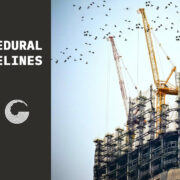CIR 03/22 | Project Risk Assessment
Further to Section 4 of Circular 01/2022 published on 21st March 2022, the Council is herewith publishing guidance on the preparation of risk assessment reports in support of waiver requests, or to be forwarded to the contractor for the preparation of method statements.
This guidance reorganises the contents of the schedules in Subsidiary Legislation 623.06 (LN 136 of 2019, as amended) such that documentation is drawn up in full compliance with current regulations while ensuring the positions of conflict are avoided.
Once discussions on the overhaul of S.L. 623.06 (LN 136 of 2019, as amended) are concluded and brought into force, it has been agreed with the BCA that the Kamra shall be issuing revised guidance on risk assessment which would not be strictly bound by the aforementioned schedules.
Guidance on
Project Risk Assessment
A comprehensive project risk assessment, drawn up by the perit responsible for the design and specification of engineering works, should include:
1. The identification of the risks involved, after taking account of the structural condition of the construction itself and contiguous buildings, including:
1.1 Description of the structure system used for floors (e.g reinforced concrete slabs, stone slabs on timber beams, concrete frame, etc).
1.2 Description of the structure system used for transmitting vertical load (e.g. masonry walls, concrete columns, foundations, etc).
1.3 Sketch plan of each contiguous building.
2. Where additional construction over an existing building or part thereof is to take place:
2.1Checks showing that any existing floors are capable of sustaining the additional load being imposed by the new construction these should include:
a) an estimate of existing and proposed loads in every floor, and a declaration that the structural elements of each individual floor are capable of sustaining the additional loads when checked in accordance with established codes of practice;
b) a description of any additional reinforcement work that may be necessary in each floor.
2.2 Checks showing that the foundations of the building are capable of sustaining any additional loads placed over the existing storeys. These should include:
a) an estimate of the existing and proposed loads at foundation level;
b) information about the nature of the foundations of the building, including type and dimensions, or where this is not available, a statement about the design assumptions in accordance with codes of practice;
c) information on the nature of the ground, supported by the respective ground investigation reports that shall be attached to the works specifications.
3. Where excavation is to take place:
3.1 A description of the loads acting on the ground within the excavation affected zone, including:
a) Clear identification of the structural system of the building, within this zone, describing how load is transmitted to the
b) An estimate of the load reaching foundation level, in kN/m or
c) Identification of the type and dimensions of foundations within this
d) An estimate of the bearing pressure at foundation level in kN/m² in the case of strip footings, pad footings and raft
3.2 A description of the excavation affected zone, explained schematically inclusive of a dimensioned plan that includes the following:
a) the limits of excavation;
b) the depth of each part of the excavation;
c) the affected zone of the excavation, shown shaded and dimensioned;
d) the properties and buildings belonging to third parties that fall within the affected zone of the
3.3 A description of the ground conditions. This should include the following:
a) identification of ground materials through the geological map of the Maltese Islands;
b) (i) information from any ground investigation reports that fall within the immediate surroundings, specifically within the affected zone; OR
(ii) information from other periti who have built or supervised excavation in the immediate surroundings, after having obtained the necessary consent to use this information; OR
(iii) information from a ground investigation that would need to be commissioned for the proposed project. This investigation shall be carried out from within the site that is to be excavated. In the case of excavations not exceeding 2m in depth, such information may be obtained from trial pits, whereas borehole drilling with full recovery shall be required for all other proposed excavation depths. If agreement is reached with the neighbouring third parties within the affected zone, boreholes shall be drilled, inclined, from within the site that is to be excavated, into the ground beneath the neighbouring third party properties.
3.4 Identification of the risks involved in carrying out the excavation, taking into account the expected strength of the ground materials, the presence or otherwise of fissures, and the loads within the affected
4. Additional Recommendations:
Moreover, the perit responsible for the design and specification of engineering works shall also include in the Project Risk Assessment requirements regarding the content of the method statement/s, including:
4.1 Any recommendations the perit deems necessary regarding the sequence of works to be undertaken on the basis of the risk assessment.
Provided that in the case of excavation, this should include:
a) where the excavation is to be started from;
b) any phasing required to achieve the required rock buttressing;
c) the levels that should be attained in each stage of the
d) Subject to the provisions of the Civil Code (Cap. 16.), where underpinning is to be undertaken, full details of how the underpinning works are to be executed, supported by scaled plans, sections and detailed drawings. A description of how the underpinning works are to be phased in relation to other excavation work needs to be
4.2 Any project-specific measures the perit deems necessary to safeguard the stability of the works being undertaken, the stability of contiguous structures or terrain as the case may be;
4.3 The precautions and safeguards to be adopted, including:
a) against instability of the structure;
b) for parts thereof being demolished or altered;
c) for any contiguous structures;
d) any monitoring readings that are required to be undertaken during demolition and excavation, describing where, how and what is to be measured and what results are to be tolerated prior to taking ulterior
Perit André Pizzuto
President









